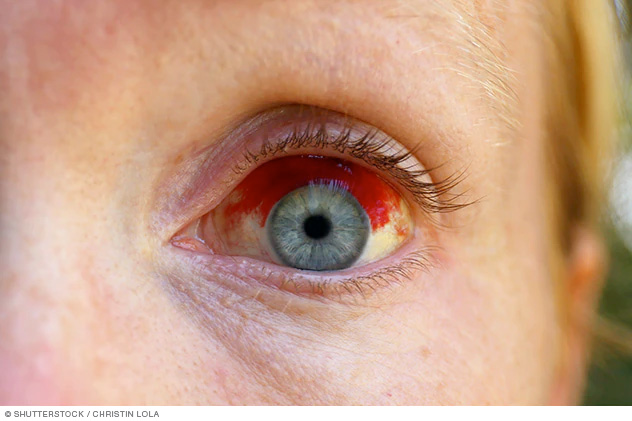Overview
Broken blood vessel in the eye

Broken blood vessel in the eye
A broken blood vessel in the eye may look alarming, but it's usually harmless.
A subconjunctival hemorrhage (sub-kun-JUNK-tih-vul HEM-uh-ruj) occurs when a tiny blood vessel breaks just underneath the clear surface of your eye (conjunctiva). In many ways, it's just like having a bruise on your skin. The conjunctiva can't absorb blood very quickly, so the blood gets trapped. You may not even realize you have a subconjunctival hemorrhage until you look in the mirror and notice that the white part of your eye is bright red.
A subconjunctival hemorrhage often occurs without any obvious harm to your eye. Even a strong sneeze or cough can cause a blood vessel to break in the eye. You don't need to treat it. A subconjunctival hemorrhage may look alarming, but it's usually a harmless condition that disappears within two weeks or so.
Symptoms
The most obvious sign of a subconjunctival hemorrhage is a bright red patch on the white (sclera) of your eye.
Despite its bloody appearance, a subconjunctival hemorrhage looks worse than it is and should cause no change in your vision, discharge or pain. Your only discomfort may be a scratchy feeling on the surface of the eye.
When to see a doctor
If you have recurrent subconjunctival hemorrhages or other bleeding, talk to your doctor.
Causes
The cause of a subconjunctival hemorrhage isn't always known. The following actions may cause a small blood vessel to rupture in your eye:
- Violent coughing
- Powerful sneezing
- Straining
- Vomiting
In some cases, a subconjunctival hemorrhage may result from an eye injury, including:
- Roughly rubbing your eye
- Trauma, such as a foreign object injuring your eye
Risk factors
Risk factors for a subconjunctival hemorrhage include:
- Diabetes
- High blood pressure (hypertension)
- Certain blood-thinning medications, such as warfarin (Coumadin, Jantoven) and aspirin
- Blood-clotting disorders
Complications
Health complications from a subconjunctival hemorrhage are rare. If your condition is due to trauma, your doctor may evaluate your eye to ensure you don't have other eye complications or injury.
Prevention
If the bleeding on the surface of your eye has a clearly identifiable cause, such as a bleeding disorder or blood-thinning medication, ask your doctor if you can take any steps to reduce the risk of a subconjunctival hemorrhage.
If you need to rub your eyes, rub them gently. Rubbing too hard can cause minor trauma to your eyes, which may lead to a subconjunctival hemorrhage.
Sept. 21, 2021